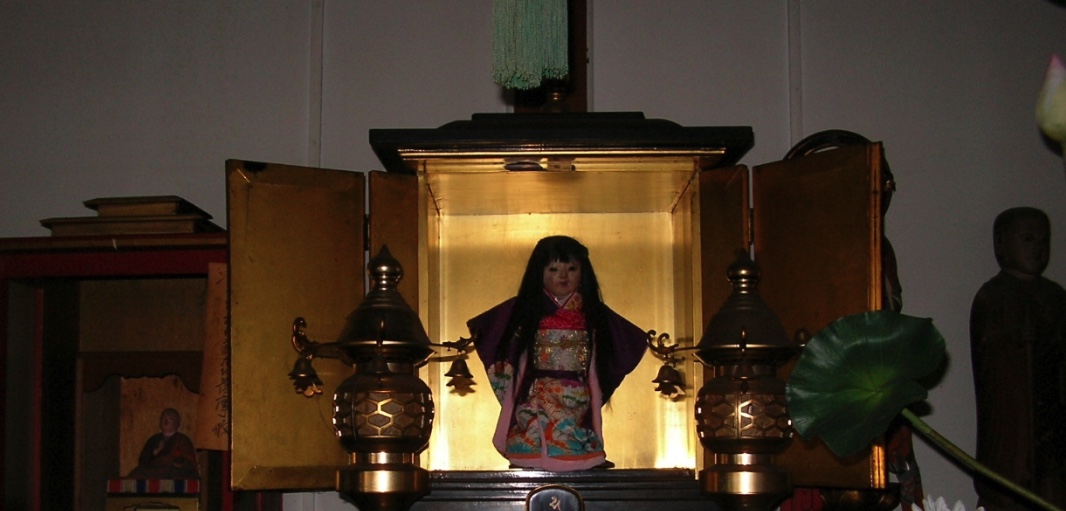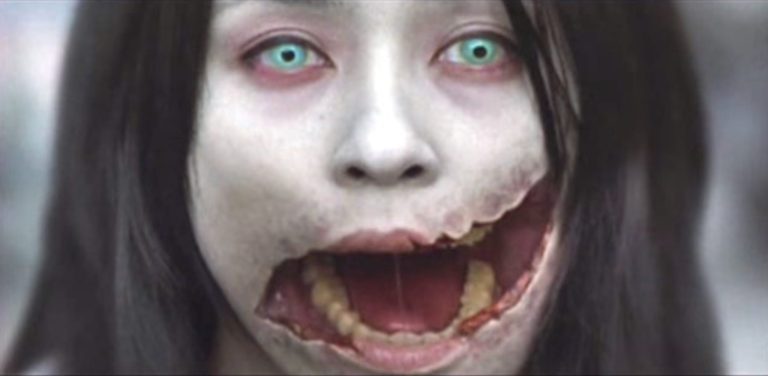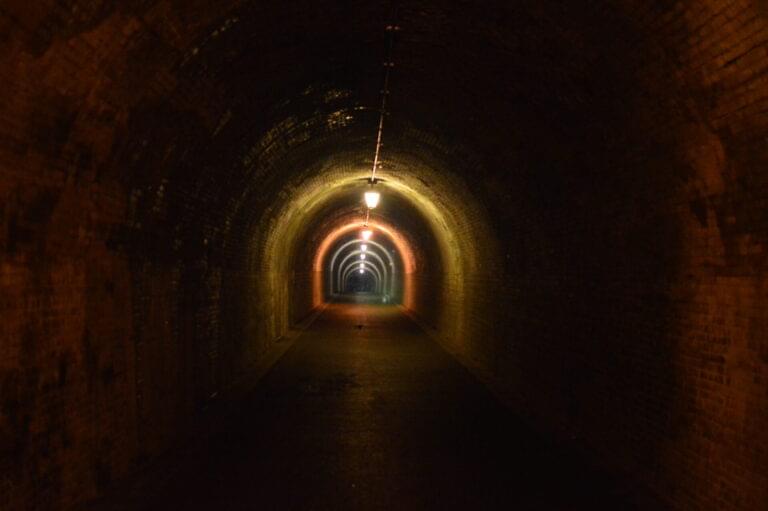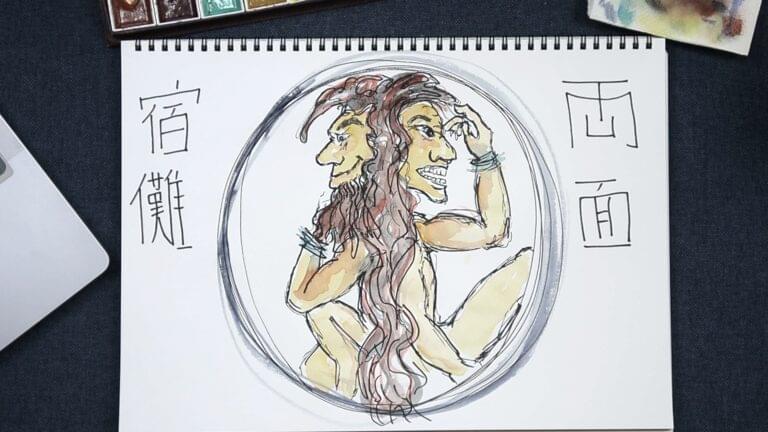Hey hey, this is Thersa Matsuura and you’re listening to Uncanny Japan.
English Versions of the Story
Consider a true story about a doll that’s hair mysteriously grows longer and longer over time. What could be creepier? Well, a whole lot of things actually, but today we’re talking about the doll. She’s named Okiku and has been a part of Japanese culture since the early 1900s. And she’s real.
While reading what’s out there about her urban legend in English, I discovered a whole bunch of quite creative and “way out” there stories. Things like how dreadfully cursed Okiku was, how she caused death and mayhem all around her, how people would waste away in her presence, and even how in time this haunted doll took on the same green eyes of the little girl she belonged to. That’s a wonderful little add right there. But this little girl in the story was Japanese and I’m saying with some confidence she probably didn’t have green eyes. One retelling ends with the dreaded doll — after killing various people — finding her way back to some shop to be sold again to the next unfortunate little girl. None of that’s true, by the way.
Stories change as they’re told, we all know that, but some of these Okiku Doll tales have become so westernized that the subtle hair raising uneasiness I so love Japan for is completely lost and the story is Hollywood horror trope-pallooza.
I’ll preface this with there are different Japanese versions of the story, too. Quite a few, actually. But I’ll try to at least remain true to the main ones and hope to show a little of the nuance that gives insight into Japanese culture and less tired cliche.
Intro:
First Version
So the story starts on August 15, 1918, when a seventeen-year old boy named Eikichi Suzuki bought a doll at the big Sapporo Exposition. The doll was wearing a kimono and had a short bob haircut called “okappa” in Japanese. He got it for his little sister, Kikuko, who was three years old.
Little Kikuko-chan adored the doll and played with it all the time, even sleeping with it. Her favorite toy never left her sight. Tragically, though, the little girl caught a bad cold the following year that led to pneumonia and she died. Some versions say it was yellow fever.
Cremation in Japan-Grave Goods
In Japan, when cremating a loved one it’s tradition for family members and close friends to put something in the casket — a small memento or item that the deceased person can take with them to the Other Side. Something that might bring them comfort. These are called fukusōhin (副葬品) which is translated as: grave goods.
Even today, there is a part, either before or during the funeral service, when close friends and family are invited to add these things to the coffin. Although again depending on the area in Japan I’m sure the timing is different. Here in my town when Ojīchan passed away, we did it right after all the prayers and words from loved ones. My son Julyan wrote and read the eulogy, and as custom when he finished, he returned the hand written speech to the envelope — with Ojiichan’s name on it — he had been carrying it in and closed it. The funeral director then asked him to be the first one to place it coffin beside ojiichan’s hand. Which he did.
Funny side note: It was a really moving speech and Obaachan, my mother-in-law, Julyan’s grandmother, was so impressed she asked Julyan if she could have it. To which — even during this very somber, quite time — every family member there said “NO! It’s for Ojiichan.” That’s funny because it so sums up her personality and being the oldest usually no one stands up to her. But they did this day.
So right before the cremation. Everyone, if they have something, places it next to the body with per haps a few words. There are some rules though. As these will be cremated with the body, the items must be flammable and not dangerous. Common items are photos, letters you’ve written to the loved one, any kind of sweets or snacks the person was especially fond of, or if they had some hobby or something they really enjoyed, maybe an item relating to that. Say, and avid fisherman could have his favorite fishing hat placed in the casket with him.
There are rules though, quite a few things are not permitted. Like anything that can interfere with the cremation. Items made of metal or glass, such as a watch or rings or glasses, since they won’t burn up entirely. Or course no matter how much your loved one like fireworks, exploding items are a big no no. Also anything that can give off poisonous gases when being burned. Certain materials, plastics, and the like.
Okiku’s Funeral
Now you can imagine the four-year-old Kikuko-chan who simply adored the doll her big brother gave her would have wanted that doll to go with her to the Other Side. And surely the family would have wanted to give it too her. Perhaps in their grief they forgot and when they realized, it was too late. Or it could have been that particular crematory didn’t allow it because of the materials it was made from. Whatever the reason. It didn’t get cremated with the young girl.
But that’s okay, the family thought, they kept her remains in an urn on their family altar, or butsudan. And beside it they placed her favorite doll. So in effect they were together. Every day the family members prayed at the altar to the memory of dear Kikuko. Only after some months did they notice something strange. The doll who had originally had a short okappa haircut, straight across just below the ears now had hair that reached its shoulders.
It was decided that Kikuko’s spirit was actually living inside the doll.
Cue 1938 and Japan entered WWII. Eikichi was conscripted and moved away from Sapporo way up north. Some stories have the whole family moving to various places, some have just Eikichi leaving. In this one everyone moved, but before doing so, they entrusted the sister’s ashes and the doll to a local temple called Mannen-ji. Why the family didn’t take it. I don’t know. This little bit of missing information adds to the creep factor. In any normal circumstances the family would of course that her and her doll with them. Maybe something was going on, maybe they did want to be rid of it.
Or maybe not, because seven years later, they return to pay their respects to her and visit the shrine. The monks had been taking good care of the doll that held Kikuko’s spirit, and is going by the name: Okiku. But startlingly, the hair had grown even longer. It was now down to its waist. A ceremony was enacted to lightly trim the hair. That grew back.
That’s when the family asked the temple to keep it indefinitely and pray over it, making sure the spirit stayed quiet and appeased. Which they agreed to and they did. Even to this day.
The Second Version

So that’s more or less the original story as I found it. But how did this private little family phenomena take Japan by storm? Because it did in the 60s. Everyone knew about the Okiku the doll. Well, let me tell you.
In August, 6,1962, in a woman’s magazine there was an article by a man named Koike Takehiko. He was a kaiden kenkyuka, or “ghost story researcher” or “paranormal researcher.”
But his version was a little different than the original story. He wrote that the doll was taken in by Mannenji in 1958 not 1938. He also said the little girl who died was named Kiyoko not Kikuko. And it wasn’t the big brother who bought the doll but her father and his name was Sukeshichi. And the father never went back to visit the doll, because he died before he could. It was the monks at the temple who noticed the growing hair.
Let’s back up. The beginning of the story is similar: Sukeshichi buys the doll, gives it to his daughter. She loves it. she dies. Instead of war, though, Sukeshichi goes off to work in the coal mines one the northernmost island of Karafuto, which is now a part of Russia called Sakahlin. Such a job wouldn’t let him take his daughter’s remains or her doll. So he asks the nearby Mannen-ji temple to hold on to them while he’s away. They basically keep the box the doll came in closed and put it away for safe keeping. Surely offering it and the girl’s ashes prayers though.
The Father’s Visit
Anyway, three years pass and Sukeshichi has not been able to return home. Meanwhile, one night at the temple one of the monks has a very vivid and disturbing dream. Sukeshichi appears beside his futon and he’s soaking wet. He begs the monk to please cut his daughter’s (not the doll’s) hair. Remember in this version of the story, they haven’t noticed any hair growing yet.
Well, the monk takes this nighttime omen seriously and since there will be no hair cutting with the urn and ashes, he goes and finds the box where the doll was being kept. He opens it and shock! Her hair has grown quite a lot since they first saw it three years prior. Another surprise, Sukeshichi died and was never able to return. Did he die just before that dream? Did he die during a storm or shipwreck? I don’t know. But he was drenched in the visitation. And that sounds like it very well could have been his last dying wish.
And much like that first story, the doll is still in existence, still at the temple in Hokkaido. And it still gets occasional trims because the hair is still growing!
The temple, honoring and not wanting to anger the girls spirit, doesn’t allow any investigative stuff to go on. But even so, in the 70s someone figured out a theory to the lengthening locks and it goes like this:
An Explanation
The hair on old dolls was made by taking a long piece of human hair folding it in half then gluing that part where it’s bent into a small hole in the scalp of the doll. So over time, it’s believed that the glue had dissolved and loosened and that one folded hair, instead of being equal lengths, began slipping so that one part gets longer, making it look like the doll’s hair is growing.
So you breathe a sigh of relief. Okiku isn’t a haunted doll. Or is it? Everything might not be so easily explained away as that.
Still Unanswered Questions
That theory would make sense, except there are no hairs getting shorter. Also, the doll is almost never touched. In order to have one end of the folded hair pulled longer you’d need someone or something pulling on it. But that doesn’t happen. And thirdly, I just looked at a recently photo of this very old Okiku ningyo and the hair is pretty much below her waist. Even if the hair was folded when made into an “above the shoulders” bob, then pulled to its maximum length it wouldn’t be that long. It’s at least three or four times longer than it should be if this theory were true. So that.
And there’s something else. In recent years there are photos of the doll and it looks like her mouth opens and closes, depending on the photo. Some have even said they’ve seen something that looks like teeth in there, too.
I’m Going to Visit Her
But the real surprise ending to the story is that while you’re listening to this — assuming you’re listening sometime around September 30th when the episode first comes out — I am at that shrine right this minute paying my own respects to the possibly misunderstood, possibly soul harboring, hair growing, mouth opening and closing doll right now.
You’re not allowed to take photos of her. But I’m sure there’s a sign outside or something I can snap and post on insta, bluesky, facebook, and discord to let you know I made the visit and left with my soul in tact. I’m also hoping I can talk to a priest or someone who’s there and get any additional information about her story. Full details of that trip on patreon when I get back. With my soul intact. *knock on wood*
Sweet dreams, everyone. Oyasumi-nasai~
I’ll talk to you in two weeks. Bye bye







Hello after reading this I got to know you visited the place. Any more factual information you got about it.